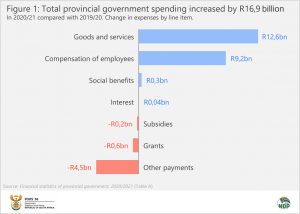Provincial government finances: the impact of COVID-19
South Africa’s 122 provincial government departments spent R613,6 billion in 2020/21, according to the latest Financial statistics of provincial government statistical release. This is R16,9 billion more than the R596,8 billion recorded in 2019/20, representing a rise of 2,8%.1
The 2,8% rise is muted compared with the previous three years that recorded increases of around 7,0%. A closer look at the data reveals that the expenditure growth in 2020/21 was driven by increases in goods and services and compensation of employees, with small positive contributions recorded for social benefits and interest (Figure 1). On the downside, provincial government spent less on subsidies, grants and other payments.
The three biggest movers in Figure 1 are explored further below.
Goods and services
Spending on goods and services jumped by R12,6 billion (or 8,7%), mainly due to increased spending by government on its response to the COVID-19 pandemic. The total amount spent on goods and services in 2020/21 was R157,9 billion. The provincial government annual reports2 show that almost R9,0 billion was specifically related to COVID-19 response expenditure.
All provincial governments reported a rise in goods and services, with the exception of Mpumalanga. The country’s place-of-the-rising-sun province recorded a decline on the back of reduced spending on property maintenance and repairs.
Compensation of employees
Provincial government plays a vital role in the administration of the country’s healthcare and education systems, which include public hospitals, clinics and schools. So it comes as no surprise that healthcare and education professionals account for the bulk of salaries and wages.
Spending on compensation of employees increased in eight of the nine provinces, rising in aggregate by R9,2 billion in 2020/21. Limpopo province was the exception, recording a decline of 0,8%. The overall increase was mainly driven by an upswing in salary payments, as well as the creation of new posts for healthcare professionals to aid in the fight against COVID-19.
A summary of staff numbers, drawn from the annual reports, shows an increase in the number of filled public healthcare posts across most provinces between 2019/20 and 2020/21, with the exception of Free State and Limpopo that recorded losses.
Other payments
The other payments line item3 decreased by R4,5 billion between 2019/20 and 2020/21, with Western Cape the only province registering an increase. The overall decline was mainly due to a delay in payments of human settlement grants to households. Government officials reported difficulties in contacting housing beneficiaries under the restrictions imposed by lockdown regulations.
For more information, download the latest Financial statistics of provincial government statistical release, together with associated Excel files, here.
This is one of several annual releases on government finances published by Stats SA. Releases for 2020/21 are available for national government and extra-budgetary accounts and funds. A release for higher education institutions is due on 27 October 2022. A consolidated release, which incorporates data from these publications, will be available on 30 November 2022. So watch this space!
1 This figure represents expense cash flows and excludes capital expenditure.
2 Provincial Government of South Africa (access the site here).
3 Other payments includes items such as transfers to households, transfers to non-profit institutions serving households, and transfers to public corporations and enterprises.
Similar articles are available on the Stats SA website and can be accessed here.
For a monthly overview of economic indicators and infographics, catch the latest edition of the Stats Biz newsletter here.


